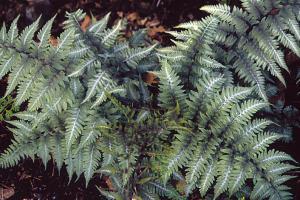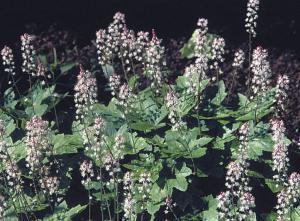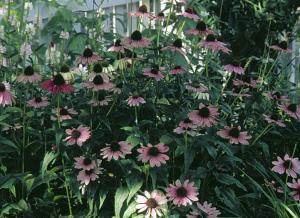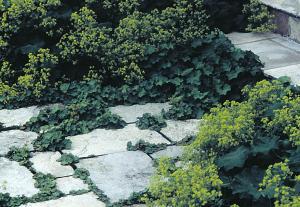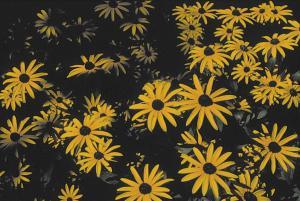By Theresa M. Forte
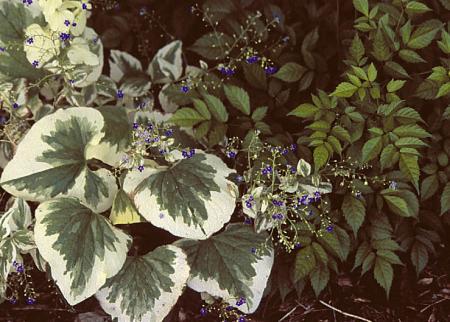 | |
| SHADE: Brunnera macrophylla 'Variegata' (Siberian bugloss) with Astilbe. |
I had a chance to demonstrate this when my son Michael and his young family moved into their first house in such a community. It was my challenge to design a garden that would be fresh and modern, with enough charm to enhance the streetscape. And, with two careers and a toddler to chase around, they needed a garden that was somewhat self-sufficient. The compact front yard was originally planted with innocent looking pyramid juniper, globe cedar, roses and purpleleaf sandcherry. Left to their own devices, these plants would crowd the entranceway and hide the front windows within a few short years. Several of the neighbours had already taken the first step and replaced these run-of-the-mill plantings with raised beds, which reflected the personality of the homeowners and enhanced the ambiance of the neighbourhood.
With a southeast exposure, the planting choices for the garden were wide open. The garden would have a blue and yellow theme, accented by the burgundy foliage of the purpleleaf sandcherries, which we left in place. Plants were chosen because they offered several seasons of interest, soothing colours, interesting foliage and/or fragrance.
|
A gentle edging was woven of Alchemilla mollis (lady's mantle), Lavendula 'Munstead' (lavender), Santolina (cotton lavender), Coreopsis verticilata 'Zagreb' and Salvia nemerosa 'May Night,' each planted in generous groups. The lady's mantle will be the first to bloom, displaying a striking shade of lime green along, contrasting beautifully with the deep indigo blue spires of the Salvia. Lavender and Coreopsis will then bloom nearly non-stop until the snow flies. A selection of grasses was planted in the middle section of the garden. One clump of each included: Helictotrichon sempervirens (blue oat grass), Pennisetum alopecuroides 'Hameln' (dwarf fountain grass) and Miscanthus sinensis 'Morning Light' (variegated maiden grass). Once established, these grasses will virtually take care of themselves and offer a refreshing, modern look to the garden. The blue oat grass creates a tidy blue dome, while the dwarf fountain grass offers further interest with its fuzzy caterpillar-like flowers all summer long. The maiden grass, with blue-grey foliage edged in white, comes to life in sunlight. Its bronzy-red flower spikes appear in fall. Along with the grasses, a Hemerocallis 'Stella D'Oro' (daylily) was included. This dwarf daylily features golden yellow flowers and blooms repeatedly throughout the season. Daylilies make wonderful companions for grasses echoing their soft, fountain-like foliage. Taller plants in the back of the border will bloom for a long season. This selection includes: Echinacea purpurea (purple coneflower), Rudbeckia 'Goldstrum' (brown-eyed Susan), Achillea 'Terra Cotta' (yarrow) and Anemone x hybrida 'Honorine Jobert' (Japanese anemone). The Japanese anemone is a beautiful older variety, featuring a cloud of single, white flowers from August to October. On the front porch, a generous clay flowerpot houses a topiary of rosemary, under-planted with Thymus x citrionus 'Doone Valley' (lemon thyme), Sempervivum arachnoideum (cobweb hens and chicks) and Swan River daisies. Strawberry jars line the stairway, and are filled with succulents and herbs; each jar is topped with Festuca glauca 'Elijah Blue' or lavender. The drought tolerant choices for all of the containers will not wilt by nightfall (and can even survive a weekend escape). The scented foliage of the herbs will greet visitors to the front porch. Each garden plot is different, however, and my next challenge lay in what creative solutions I could bring to the neighbours on the opposite side of the street. Many of these urban gardens have entrances that rarely bask in the sunlight. Are they doomed to a monotonous bed of impatiens? The solution: A shade-tolerant garden filled with sophisticated perennials and shrubs with white accents. The colour white illuminates shady gardens and brings them to life. White flowers appear fresh, cool and calming in a garden, particularly when combined with light green foliage. (They have the same effect when they are included in gardens that can be enjoyed in the evening). I assumed the neighbour's lifestyles were equally as busy, so plants were selected with a careful hand to be low-maintenance and remain interesting over several seasons. Viburnum plicatum 'Summer Snowflake' forms an upright mound, suitable to place in either back corner of the bed. In the centre, a Japanese cutleaf maple such as Acer palmatum 'Shaina' (a dwarf version of Bloodgood) would be ideal, with its bright red foliage, which matures to a deep maroon-red. Good candidates for the middle section include Heuchera 'Bressingham Bronze' with its outstanding beet-red foliage, which will echo the red of the Japanese maple, and H. 'Checkers', with silvery-metallic foliage and showy white flowers which appear in June. Good neighbours for the heucheras are members of the Tiarella (foamflower) family. One of my favourites is T. 'Iron Butterfly', featuring large spikes of fragrant white flowers rising above superbly cut foliage with burgundy veining. Iris ensata 'Variegata' (Japanese iris) or Hakonechloa macra 'Albo-striata' (try saying that twice!) can take up residence on either side of the bed, placed in front of the viburnums. Both feature grassy foliage, edged in white, which looks very exotic. The iris is more erect, while the Hakone grass cascades gracefully (also perfect for an elegant container planting on the stairway). In the centre of the bed, place a grouping of the Astilbe 'Hennie Graafland', which showcases bronzy-green leaves on dense plants. The soft pink flowers appear in late summer, just when most shade gardens are in need of a dash of colour. Finally, edge the bed with generous colonies of the following groundcovers: Cornus canadensis (bunchberry) is a native Canadian with white dogwood-like flowers in May, the foliage turns delightful shades of red and green; Galium adoratum (sweet woodruff) features dainty white flowers in the late spring and bright green finely cut leaves, which remain fresh looking until fall. For a bold touch, use Brunnera macrophylla (Siberian bugloss), with heart-shaped leaves and bold edges of creamy white. Place this dynamic plant in full shade so it does not scorch, and next to solid coloured leaves such as sweet woodruff and astilbes to show the creamy white markings to its best advantage. Do not assume you are limited to a few choices for a town garden with a northern exposure. With a little research, a sophisticated, easy-care garden is possible. I hope these colourful, low maintenance gardens will encourage the neighbours on either side of the street to create their own signature gardens and resist the temptation to settle for mere foundation plantings. Theresa M. Forte is a garden writer and photographer based in Niagara Falls, Ont. |
